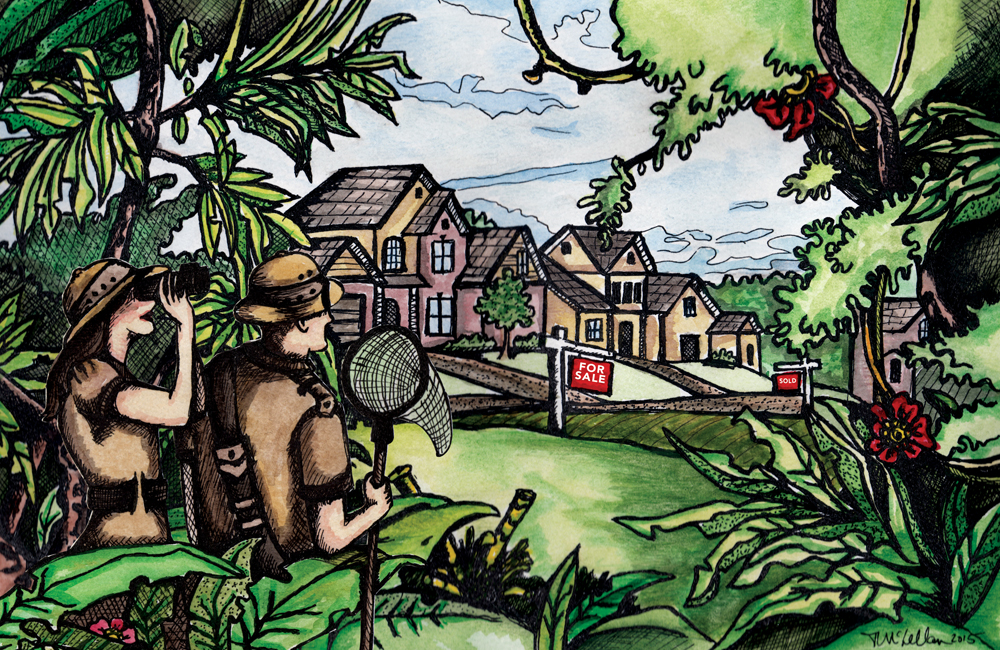Buyers and sellers in Southern Georgian Bay are battling it out over price in the resale home market
![]() t’s still a buyer’s market for resale homes in Southern Georgian Bay – but with a twist: many sellers are sticking firm to higher prices, even at the risk of not selling. Meanwhile buyers, seeing that the supply of homes for sale exceeds demand, are looking for ‘deals’. It’s a tug-of-war between buyers and sellers on price, and realtors say both should be more realistic.
t’s still a buyer’s market for resale homes in Southern Georgian Bay – but with a twist: many sellers are sticking firm to higher prices, even at the risk of not selling. Meanwhile buyers, seeing that the supply of homes for sale exceeds demand, are looking for ‘deals’. It’s a tug-of-war between buyers and sellers on price, and realtors say both should be more realistic.
“Essentially, one out of three-plus properties listed for sale on the local MLS [Multiple Listing Service] market actually sells,” notes Rick Crouch, broker and market value appraiser with Royal LePage Locations North in Collingwood.
“On the surface, you could say that it is a buyer’s market; however, that would suggest prices are falling and/or there are some real bargains out there – and nothing is further from the truth.”
This area is unique, adds Crouch, because many prospective buyers are looking for a second home as opposed to a primary residence, so they don’t ‘have’ to buy. By the same token, many area sellers don’t have to sell and won’t be pressured into accepting a bargain-basement offer.
“The number of expired MLS listings in the area increased by almost five per cent last year as many sellers, unable to secure a buyer and unwilling to drop their asking price considerably, simply took their properties off the market until such time as conditions improve,” explains Crouch.
That trend towards almost a balancing-out of the market appears to be continuing this year: in February the number of resale properties listed for sale saw the largest decline in a decade.
“We anticipate that the market overall will remain ‘steady as she goes’ with a slight overall growth year over year,” predicts Andres Paara, president of the Georgian Triangle Association of Realtors (GTAR). “From all indications the interest rates are anticipated to remain at the presently enjoyed historic levels.”
The market overall was “creeping from a buyer’s market to a balanced market as 2012 progressed up until November,” he adds. “Since then we dropped slightly back towards a buyer’s market with the amount of inventory available versus the number of sales. On the positive for the sellers, we have started 2013 off with more property sales overall and a higher total in dollar sales as well.”
Strength In Numbers
Last year was the second-best year on record for the GTAR. Sales were up six per cent in 2012 over 2011, despite a softening of the market in November and December year-over-year.
The overall positive trend seems to be continuing so far in 2013. Unit sales for February year-to-date posted a modest increase of 3.9 per cent, while dollar sales were up 2.6 per cent. The average price for a home rose 9.6 per cent to $362,477 in the first two months of 2013 compared to the same period last year (it is interesting to note that this is within $200 of the national average price for a home). Sales of homes priced over $1 million fell 57.1 per cent, with three homes selling for over $1 million in the first two months of this year compared to seven in the same period last year.
The hottest category was the $500,000 to $1 million range, up 50 per cent over the same period last year.
“Statistically overall for our region of the Georgian Triangle, the higher end at $500-$1 million continues to be very strong carrying forward from 2012 to 2013,” says Paara. “This continues to play along with the recreational buyers that are now buying a year-round use property than what, in the past, was a more modest winter seasonal use only. The other factor is the buyers that are selling their big homes and replacing with a small condo in the GTA and buying what will become their retirement property as they transition their primary residence in our region.”
Homes priced under $200,000 saw a 20 per cent rise in sales. However, those in the $200-$349,999 category declined by 1.8 per cent while sales between $350-$499,999 fell 12.8 per cent.
“The $350-$500,000 homes are showing to be the toughest as they are too much money for some of the seasonal recreational buyers and/or the local young families, and are not nice or big enough for the year-round users or the semi-retirement or retirement market from the GTA,” notes Paara.
“We anticipate that the market overall will remain ‘steady as she goes’ with a slight overall growth year over year. From all indications the interest rates are anticipated to remain at the presently enjoyed historic levels.”
However, while January and February together made for strong year-to-date numbers, January was very strong whereas February showed a decline, mirroring a softening of the Toronto market in February. As On The Bay went to press in mid-March, it was unclear whether March would continue that downward trend, or bounce back to January’s stronger numbers.
Influencers
Navigating today’s real estate market can be daunting, with tougher mortgage lending guidelines and economic uncertainty having an impact across the country.
“The tightening up of the mortgage lending requirements had some negative impact on sales in the area as we saw more conditional sales fall through last year, stemming from buyers being either unable to secure financing and/or they required more time to save the added amount required to meet increases in the minimum down payment requirements,” says Crouch. “During the past couple of years we have also seen a significant rise in the number of power of sales in the area, with some buyers finding themselves over-extended or they are perhaps in cash flow difficulties resulting from a job loss or other economic factors.”
Adds Paara, “The negatives are the doom and gloom economic statements and the high per capita Canadian debt the media keeps talking about, which softens the consumer confidence.”
Again, the discretionary nature of many home purchases here is a factor. “Before making a large discretionary purchase, many buyers examine external factors such as the stability of the world economy, and how that affects their personal investments and holdings,” says Desmond von Teichman, broker of record with Royal LePage Locations North. “The uncertainty in the financial markets in 2012 has continued to curb growth in our real estate market. On the plus side, we did not see a decrease in the market at large, which speaks to the strong fundamentals in our area.”
The Toronto market has recently softened, and that could also impact our local market. However, Paara sees Toronto’s slump more as a correction than a decline, as city markets that remained inflated through the economic downturn may just now be starting to feel the impacts. The Canadian Real Estate Association (CREA) attributes much of Toronto’s February decline to tougher mortgage regulations that make it more difficult for first-time buyers to enter the market, whereas first-time buyers are a negligible portion of our local market.
On the positive side, the pace of household debt is slowing, while ongoing historical low interest rates and the gradually aging demographics of the Southern Ontario population are continuing to drive recreational use purchasers as well as semi-retired and retired buyers from the GTA and surrounding regions to the four-season active lifestyle communities of Southern Georgian Bay.
“I see us being in slightly better than a flat market, not a declining market,” says Paara, adding, “I see steady growth in the long term.”
Location, Location, Location
It’s not hard to sell location anywhere in Southern Georgian Bay. However, there are some pretty significant geographical differences in unit sales and prices from area to area across the region. The Blue Mountains, Collingwood and Wasaga Beach are remaining fairly strong, while Clearview, Meaford and Grey Highlands are continuing a downward trajectory, in part due to existing and proposed wind turbine installations in those areas.
The Blue Mountains posted a 17.4 per cent increase in unit sales but a 3.8 per cent drop in average price, to $518,818, in the first two months of this year compared to the same period last year. Collingwood unit sales were flat, but the average home price increased by 2.1 per cent, to $239,296. Sales in Wasaga Beach rose 6.1 per cent and the average price fell a marginal 1 per cent, to $273,451.
On the flipside, sales in Grey Highlands were down 35.7 per cent, but the average price rose 6.1 per cent to $349,024. Meaford continued its downward trend with sales dropping 14.3 per cent and average price falling 4.5 per cent to $271,822. And Clearview’s sales declined by 22.7 per cent, with the average house price falling 2.3 per cent to $303,646 in the first two months of 2013 compared to the same period of 2012.
“The Mega Quarry proposal had the largest negative impact on home sales in our area, and following a close second are wind turbines,” says Austin Boake of Re/Max Creemore Hills Realty. “The announcement that Highlands [developer of the Mega Quarry project] withdrew their application had an immediate, positive effect on our market.”
However, he adds the numbers are deceiving, because Clearview doesn’t have a lot of homes for sale. “We do not have a lot of new construction and little turnover as people tend to stay put once they get here,” he notes, adding, “In a lot of cases the children are taking over the properties.”
The Condo Market
Our condo market remains soft, again largely because condos tend to be a discretionary purchase as weekend getaways and are impacted by eroding consumer confidence.
However, there are some positives to the condo market in Southern Georgian Bay compared with Toronto and elsewhere.
“Our condo buyers are predominantly end users,” explains Maureen Gowans, broker of record at Clairwood Real Estate in Collingwood. “This is markedly different to the Toronto market where there are a lot of investors in the condo market. The Toronto market is showing the negative effects of investor-buoyed prices. It is definitely preferable to have end users to keep the condo market afloat. We are in that better position.”
Another positive: condo buyers tend to range from young families to active older retirees, creating a large pool of buyers. The turnkey element is also attractive.
“There continues to be demand for condo living without the worries of maintenance since these properties can be the primary home but many are second and even third homes,” notes Gowans. “The demand for condos in our area will remain, although it too is soft at the moment and could remain soft for the near future.”
Lifestyle & Demographics
Those thinking of buying a home in Southern Georgian Bay are buying into a lifestyle, and that bodes well for our local real estate market for years to come.
“Our little corner of the world might fare better than most as our area offers that lifestyle or recreational property that is just one-and-a-half hours from the big city,” says Gowans. “Many baby boomers are looking at retirement, and where better than Southern Georgian Bay? The population values their leisure and quality time very highly … escape from the concrete jungle to where the whole family can gather and be active together, plus all the Village at Blue offers makes our real estate very appealing.”
The demographics continue to be weighted towards retirees and semi-retirees, but there are more and more young families and professionals looking to enjoy all that our region has to offer. Unfortunately, there are not a lot of job prospects, so living here full-time is just not possible for some younger professionals.
“The most significant factor impacting our real estate market overall is the lack of any economic development initiatives in the area,” laments Crouch. “Since 1986 when the shipyards closed, we have seen a steady migration of higher paying jobs leave the area with nothing but retail and service industry jobs coming in as replacements. Record low mortgage rates are of no consequence to a buyer that is displaced from their work or is making little more than minimum wage. This impacts what I refer to as the ‘traditional’ housing market: the market that represents the needs of local families, not retirees moving here from the GTA or those looking to buy a weekend retreat.”
With part-timers, business owners, creative types and retirees continuing to drive our real estate market, there are challenges to be sure, but the upside is that our area will continue to build on its new foundation as a four-season recreational paradise.
“I think that we will increasingly see a focus on lifestyle and amenities in this area,” notes von Teichman. “I think real estate with excellent access to recreational amenities will continue to see disproportionately high value relative to real estate on the periphery of those amenities. From a design and build standpoint, I think we will continue to see better use of outdoor spaces and an increased focus on lifestyle from entertaining to great storage spaces for our ‘toys’.”
Paara concurs. “Our area will continue to be a retirement and recreational market for years to come,” he predicts. “When the economy is sluggish we’ll continue to see slight growth, and when the market is strong we will grow more than some other markets. Buyers are looking at what is their motivation and what are their end goals; what having a place here does for your life. I don’t see that changing.”
Advice for Buyers & Sellers
Not surprisingly, the realtors we interviewed recommend hiring a competent professional first and foremost. If you don’t already have a realtor you trust and enjoy working with, ask friends or colleagues for recommendations.
“You have choices,” says von Teichman about finding a realtor to help you sell your home. “You should interview realtors and get specific information about what they can do for you. You should expect and demand personal, professional and progressive real estate services. Putting up a simple sign and crossing your fingers is not a good way to recognize the value of your largest asset.”
And it’s not just sellers who need the help of a good realtor; buyers also benefit, adds Crouch. “Over the years I have seen many buyers overpay for a property that they purchased privately,” he notes. “The tendency is for buyers to believe that because there is no commission being paid to a realtor, every private sale is a good deal and nothing can be further from the truth. A realtor will not only counsel a buyer as to the appropriate price but they will also ensure that the appropriate conditions and clauses are included in an offer to protect the buyer’s interests.”
It’s especially important to work with a local realtor who knows the area and is familiar with issues that may affect the value of a home now and in the future, such as septic wells, landfills, quarries, wind turbines, etc.
But beyond engaging a professional, there are some things both buyers and sellers can do to ensure success in today’s challenging market.
“Contrary to what sellers may believe, there is one thing and one thing only that sells a property, and that’s price,” maintains Crouch. “The style of a home, its location and condition, etc. are all important attributes but essentially these characteristics are all a function of price. If a seller is truly committed to selling their property it must be priced appropriately in order to attract a buyer. No amount of print advertising, elaborate virtual tours and other marketing initiatives will sell a property that is perceived by a buyer as being out of sync with market pricing.”
Sellers need to realize that today’s buyers are savvy and plugged in. “There is no fooling today’s consumer,” cautions Crouch. “Most buyers contemplating a real estate transaction are searching for properties online. By comparing properties online they have a good sense of value and they know what properties are lingering on the market. Over-pricing a property is a frustrating proposition for everyone and with mortgage rules being tightened even if a buyer is prepared to pay a seller’s inflated price, the property will have to pass the scrutiny of a bank’s appraiser; otherwise they can forget about securing a mortgage.”
Gowans adds that resale homes are competing with new homes where buyers can choose their fixtures. “The resale homes that are older and dated are a long, difficult sell unless the price is right. The buyers are used to and demand all the new bells and whistles.”
For buyers, it’s important to understand the dynamics of the market segment and plan your negotiation accordingly, says Stephen Simon, sales representative at Royal LePage Locations North in Thornbury.
“If you are buying into a segment with high level of inventory relative to the rate of sales, you can expect to get better value. And of course the opposite is true if you are buying in a segment with lower levels of inventory relative to the rate of sales.” The bottom line: both buyers and sellers need to be informed, patient, and realistic.
It is unlikely the market will completely balance out or tip towards a seller’s market in the coming year. As we go to press in mid-March, it’s unclear whether the softening of the Toronto market will continue and, if so, how it will affect us, as low mortgage rates and pent-up demand could still turn the tide back to a position of strength. In any case, local realtors insist that the long-term prospects for real estate in Southern Georgian Bay remain strong as interest rates are projected to remain low and discretionary buyers continue to look to our region for its location and lifestyle. For sellers, it’s a competitive market to be sure, and for buyers the search offers many choices. Those who take their time and do their homework will fare best.![]()














